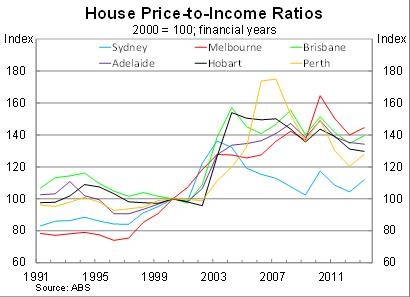Prepare for a house price plateau
How much more can investors get out of the housing market? Not a great deal.
The 2013 house price ‘boom’ – if we can call it that – has largely been a Sydney affair, with real dwelling prices in other capital cities growing at a rate consistent with income growth, or in the case of Brisbane and Adelaide, barely growing at all.
Investors have jumped on board the Sydney bandwagon but if they have invested in other cities recently then they would be disappointed in the results.
The state national accounts, released last week, provide information on the average gross disposable income in each state. This data can be used to assess which states have the highest relative house prices.
The house price-to-income ratio is below its peak in each city, in some cases significantly so. Generally the ratios show broadly similar trends with two main exceptions: Sydney house prices tend to do their own thing and Perth house prices rose to unprecedented highs during the first commodity price boom.

It is however important to note that by indexing the ratio I am capturing the change in the house price-to-income ratio rather than the absolute level of the ratio. The level of the ratio has traditionally been higher in Sydney, as Sydney’s diabolical public transport system ensures that people need to live close to amenities (plus the harbour is fairly pretty). However, due to weak house price growth over the past decade, the premium to live in Sydney is no longer as great as it once was.
The most recent peak for each city came during 2009/2010, during which house prices were supported by a first-home owner boost that was largely unprecedented. Once that was removed relative prices declined across the country.
During that period, growth in household gross disposable income slowed across most states, with Western Australia the notable exception owning to the mining investment boom. In 2012/2013, gross disposable income was largely unchanged in New South Wales, Victoria and Queensland.

With the unemployment rate expected to rise and the participation rate likely to slide further as more ‘baby boomers’ begin to retire, household income growth should be fairly modest in most states in the 2013/14 financial year.
Income growth in Tasmania has been particularly weak in recent years and it was no surprise that Tasmanian Premier Lara Giddings announced a doubling of Tasmania’s first home owner grant to $30,000 or around 10 per cent of Hobart dwelling prices. Of course the grant won’t help Tasmanians afford their own home, the policy is an abject failure wherever it has been done, and will most likely reverse the trend of increasingly affordable housing in Tasmania.
So for investors, where should they be investing? The reality is that most cities are not great investment choices right now.
The house price-to-income ratio increased in Sydney, Melbourne and Perth during the September quarter and is now at levels that would be considered high given the prevailing economic conditions.
Low interest rates will support house prices and lending but subdued household income growth is likely to persist for some time and that will be the biggest driver of house prices in the years ahead. The potential for investors to flip properties for large capital gains is limited if buyer activity slides and that will inevitably happen if income growth is as weak as many expect.
Given the outlook for the economy, new investors will be left to fight over the scraps in the housing market. The current level of price growth nationally is unsustainable without greater activity from owner-occupiers and potential first home buyers and I don’t see that demand picking up anytime soon. Expect price growth to slow and perhaps even decline in 2014.













